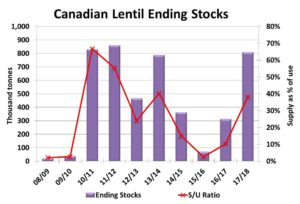I’ll be the first to admit the 2016/17 pea market, especially for yellows, has performed better than expected. Essentially, it’s been due to exceptionally heavy demand from India and, to a lesser extent, China and Bangladesh. The Indian demand is especially a surprise, given its improved rabi pulse crop and record volumes of Australian chickpeas moving into the country.
Canadian pea exports were 515,000 tonnes in March, far beyond normal and last year’s pace. The large majority were yellow peas, but green pea exports have also started to improve in the past month or two. And it appears the pace hasn’t slow down much in the short-term. The weekly CGC export data shows big volumes in April as well.
The strong prices are also in spite of a record Canadian pea crop that, in all likelihood, was underreported to StatsCan last fall. Those production numbers will eventually be adjusted by StatsCan, but won’t really have any market impact at this late stage. Even if the numbers aren’t adjusted, the idea that 5.0 million (or more) tonnes of Canadian pea supplies can almost all be consumed is impressive.
All of this points toward solid pea bids for much of the rest of 2016/17, but even that strength will take a break at some stage when old-crop values transition to lower new-crop prices. Most likely, that’s going to start showing up already in late May when offshore buyers can afford to wait until the 2017 harvest.
Of course, the more important question is what will happen in the next marketing year. StatsCan has already forecast seeded area to decline by a few percent and that’s not catching anyone by surprise. The planting delays caused unharvested acres in Alberta and Saskatchewan are adding another layer of uncertainty to the final acreage picture, with the potential for even fewer peas going in the ground.
The ongoing discount for green peas relative to yellows means that the acreage declines will be especially severe for greens while yellows could be steady. Ultimately, that shift will add some support to new-crop green pea bids compared to yellows. This should finally bring green peas back into a more normal premium over yellows.
The largest source of uncertainty is (as always) the yield outcome for the 2017 crop. Last year’s yield was exceptional, averaging almost 43 bu/acre across the prairies, the second highest on record. Even if 2017 yields just drop back to the 5-year average around 38 bu/acre, the 2017 crop would be 15-20% smaller than last year and that’s friendly for prices. Even so, a 4.0 million tonne crop would still be the second-highest on record. A word of caution though; yield estimates at this stage of the year are purely guesses. Yields close to the average simply have the highest odds of occurring.

It should be noted though that pea acreage in countries like Russia and Ukraine is rising and they will be competing for Indian business along with the Australians, Americans, French and others. And because India is the cornerstone of global pea trade, any shifts either positive or negative would have considerable impacts.
The bottom line after all these factors is that I’m fairly friendly toward the 2017/18 price outlook, especially after the harvest lows are in. And I’m even friendlier toward green peas than yellows, but that’s not new. And this comes from a guy who’s underestimated the 2016/17 market, so take it for what it’s worth.